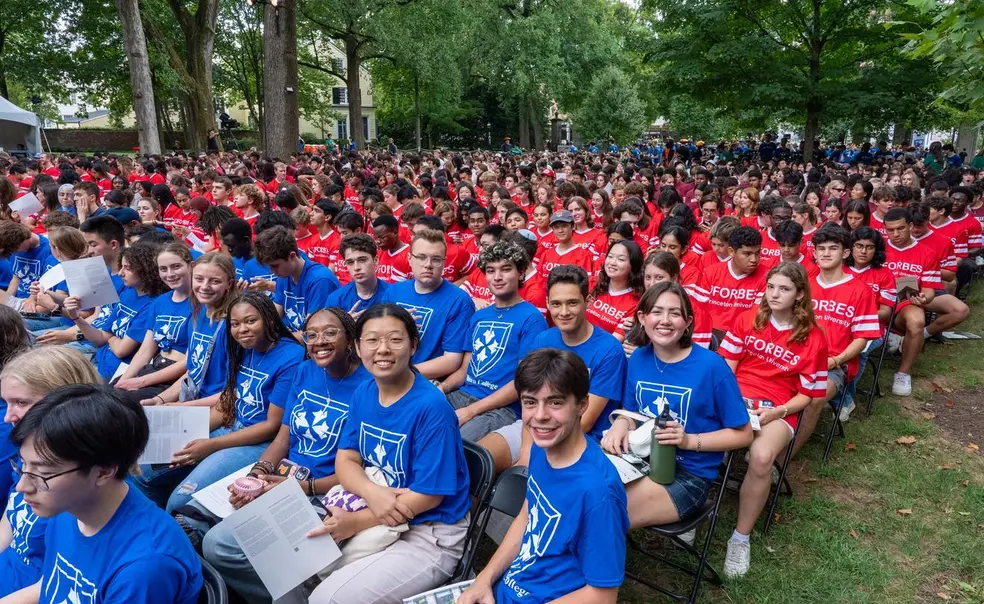Princeton Expands Financial Aid Across Income Spectrum
Beginning this year, all costs will be covered for most families earning less than $150,000
Two weeks before the arrival of the Class of 2029, Princeton announced that undergraduates from most families earning up to $150,000 a year will not have to pay for tuition or room and board at the University, most families earning up to $250,000 will pay no tuition, and many United States-based families earning up to $350,000 will receive grant aid, including higher-income families with multiple children in college.
This marks the largest financial aid increase since 2022, when the University announced it would be free for families that make under $100,000, increasing from $65,000. The Class of 2029 has the highest share of students eligible for federal Pell grants in the University’s history, with approximately 25% qualifying as lower-income, up from 21.7% in the Class of 2028.
“Through our increased investment in financial aid, we are making the transformative experience of a Princeton education more affordable for more students than ever,” Provost Jennifer Rexford ’91 said in an Aug. 7 press release.
The news comes as the University faces a potential 8% endowment tax. According to the Tax Policy Center, a nonpartisan collaboration of the Urban Institute and the Brookings Institution, universities may be able to avoid the endowment tax by expanding their financial aid policies and reducing the number of “tuition-paying” students. It is unclear how the new aid policy will affect the number of students paying tuition at Princeton. The University declined to respond to several questions for this story.
As of July 29, 69% of the 1,409 incoming freshmen qualified for financial aid. According to the University announcement, endowment payouts dedicated to financial aid cover almost 70% of the undergraduate financial aid budget.
In April, the University planned for an 8% increase in the financial aid budget to $306 million for the 2025-26 academic year. With the new policy, the University is projected to spend $327 million on financial aid, an approximately 15.5% increase.
Every Ivy League school offers full tuition to students from low-income families, though the income thresholds vary from Cornell ($75,000) to Harvard, which expanded its financial aid in March to be free for students from families earning up to $100,000 and tuition-free up to $200,000. With the recent changes, Princeton’s policy is the most generous in the Ivy League. In 2001, the University was the first in the country to eliminate loans from its financial aid packages.
The University’s release announcing the financial aid changes also provided demographics for the incoming freshman class. The percentage of incoming students who chose not to identify their race or ethnicity grew to 8.2%, up from 7% for the Class of 2027 and 5.5% for the Class of 2026, consistent with national trends following the Supreme Court’s 2023 decision that limited consideration of race in admissions decisions.
The percentage of incoming students self-identifying as Black or African American dropped to 5%, down from 8.9% for the Class of 2028. The percentage who self-identify as white dropped to 28.5% from 31.3%. The percentage of students who identify as Asian American rose to 27.1% from 23.8%.
International students rose from 12.1% to 14.1% of the incoming class and represent 65 countries. The percentage self-identifying as Hispanic or Latino (9.2%), multiracial (7.7%), American Indian or Alaska Native (0.1%), and Native American or Pacific Islander (0.0%) remained consistent with previous years. These numbers represent U.S. citizens and permanent residents only.
Thirty-two transfer students will join the undergraduate student body, including 22 who have served in the U.S. military and 27 who are matriculating from community colleges, mostly in New Jersey.
Students hail from 47 states plus Washington, D.C., Guam, the Northern Mariana Islands, Puerto Rico, and the U.S. Virgin Islands; 16.7% are first-generation college students and 12.4% are children of alumni. Nearly two-thirds of the class indicated interest in the University’s bachelor of arts degree, 27.3% in the bachelor of science in engineering degree, and the rest remain undecided. The Class of 2029 moves onto campus on Aug. 22.












No responses yet